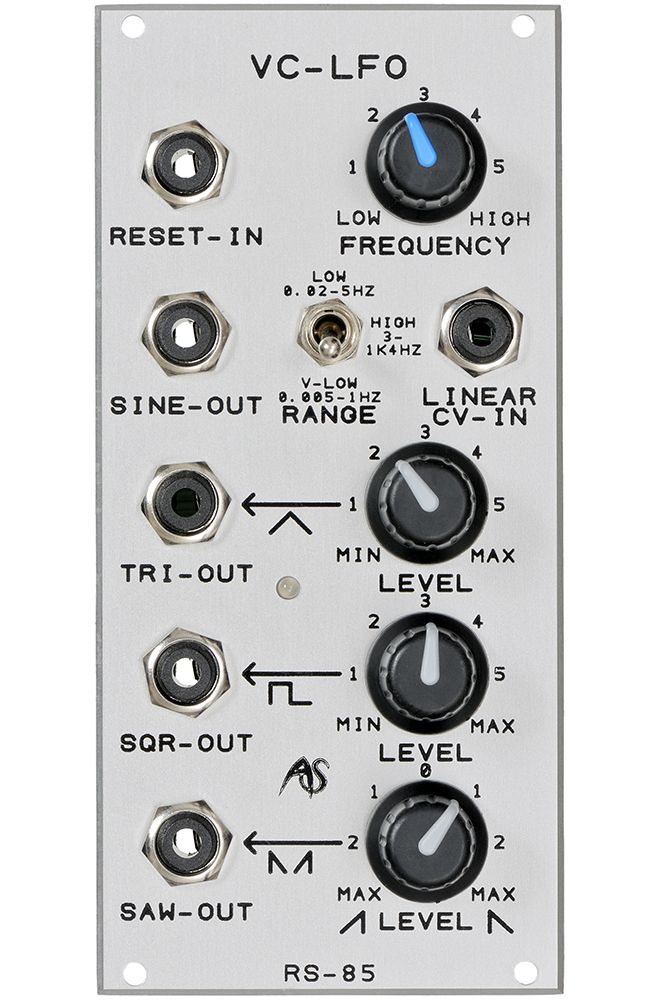Analogue Systems
RS-85
VC-LFO
The Analogue systems RS-85 module is a voltage controlled LFO with four wave form outputs, reset and a very wide frequency range, up to audio frequencies so you can use the module as an auxilliary oscillator.
Not all periodic oscillations lie within the range of audible frequencies,but this does not mean that you cannot hear them. For example, a violinist’s vibrato may take the form of an oscillation at,say,5Hz,while the growl produced by over-blowing a brass instrument may occur at 18Hz. Even in isolation, you may hear a periodic waveform at subsonic frequencies - for example, a clock oscillator with an output of 1Hz will sound like a series of repeating clicks. (Strictly speaking, these have a high bandwidth due to the transient nature of the waveform, and you would not hear a sine wave at the same frequency, but that is not the point.)
Synthesisers have a class of oscillators- Low Frequency Oscillators (LFOs) - that create these, and many other, effects.They can add vibrato to a sound, produce growl, act as low frequency clocks and, on some synthesisers, double as audio frequency oscillators.
In use :
The RS-80 and RS-85 are flexible LFOs with extremely low minimum frequencies (one cycle every 50 seconds on the RS-80 and one cycle every 200 seconds on the RS-85) that allow you to create a wide variety of modulations and effects. Their maximum frequencies lie in the middle of the audio range so they can be used in three ways: as low frequency modulators; as audio frequency modulators; and as secondary sound sources. It is therefore vital that, just like a primary audio oscillator, they exhibit pitch stability, waveform accuracy, and a lack of unwanted noise and/or distortion.
FREQUENCY
The RS-85 FREQUENCY knob has three ranges:
- High
- Low
- V-Low
You may control the LFO rate by applying a suitable CV to the LINEAR CV IN socket. This conforms to the Hz/Volt standard used by Yamaha and most Korg monosynths. If you use it as a conventional oscillator you will find that it produces a different tone to the RS-95 oscillator, adding flexibility to the synthesizer.
-
HIGH:
Turning the FREQUENCY control from its minimum to its maximum will cause the LFO to produce a range of frequencies from 3Hz to 1,400Hz.
-
LOW:
Turning the FREQUENCY control from its minimum to its maximum will cause the LFO to produce a range of frequencies from 0.02Hz to 5Hz
-
V-LOW:
Turning the FREQUENCY control from its minimum to its maximum will cause the LFO to produce its lowest range of frequencies from 0.005Hz to 1Hz
WAVEFORMS
The LFOs generate four waveforms simultaneously. The sine and triangle waves are often used for imitating acoustic characteristics such as vibrato and tremolo. The square wave is suitable for acoustic effects such as trills as well as for controlling many other aspects of the synthesizer. Finally, there is a sawtooth wave that can assume rising- (ramp) and falling- (sawtooth) shapes.
-
SINE:
This has no associated level control and, in normal use (i.e. with no oscillator sync applied), it outputs a ±5V sine wave at the current LFO frequency.
-
TRIANGLE:
The level is controlled using the associated LEVEL control, and has a maximum output of ±5V
-
SQUARE WAVE:
The level is controlled using the associated LEVEL control, and has a maximum output of ±5V
-
SAWTOOTH:
The level is controlled using the associated LEVEL control, and has a maximum output of ±5V. The sawtooth waveform can be inverted from a rising sawtooth to a falling sawtooth waveform by turning the LEVEL control from its fully anticlockwise position through to its fully clockwise position. No output is obtained when the knob is at its 12-o'clock position. On the RS-85 the LEVEL knob has a centre detente that allows you to find the zero position quickly and accurately.
RESET IN
The LFOs offer a reset function (sync) taht re-initialises the waveform when a second signal is applied to the RESET input. This re-initialises the LFO waveform every time taht a positive-going voltage is detected.
If the reset signal is a low-frequency periodic waveform, it will retrigger the LFO. If the reset signal is a mid- or high-frequency period waveform, it will act as a sync input, increasing the harmonic complexity of the waveform generated by the LFO. If the reset signal is aperiodic, more complex effects will occur.
STATUS LED
The status LED gives you a direct visual indication of the LFO frequency.
